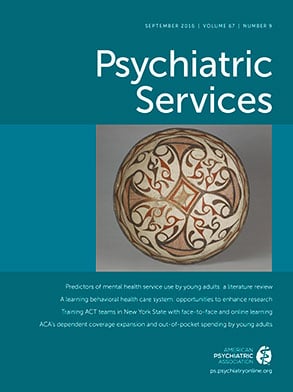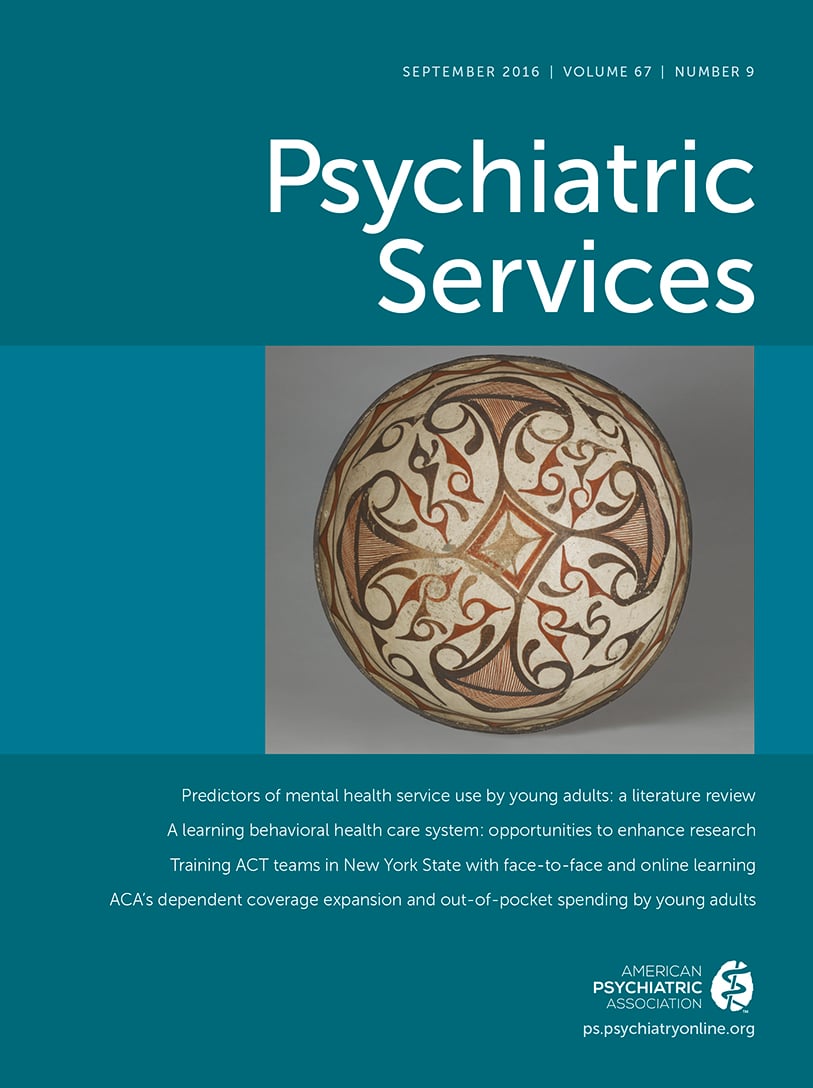The lifetime prevalence of depression may be as high as 20% among adolescents (
1). Specific psychopathology begins to develop at this stage of life and is partly influenced by the psychodynamics of the process of adolescence itself. Therefore, when psychiatric treatment is required, the fragile self-image of adolescents and their generally unstable self-esteem become even more relevant, especially if intensive treatment in a hospital setting is required. Consequently, intensive treatment should be adjusted to the needs of adolescents’ emotional development. Although several studies have examined the role of intensive “milieu therapy” as a part of day hospital treatment for various psychiatric populations (
2,
3), data regarding the efficacy of such treatment among adolescents with emotional or depressive disorders are rather scarce (
4–
8), especially in terms of recent findings. This column describes a day hospital in Belgrade, Serbia, and presents findings of a recent evaluation.
The Day Hospital for Adolescents
The Day Hospital for Adolescents (DHA) of the Institute of Mental Health in Belgrade, Serbia, was established in December 2007. It serves youths ages 15–25—in the middle, late, and postadolescent phases—whose internalizing and externalizing problems lead to dysfunction in several domains, such as social and educational. The core of the DHA concept is the case-management team (CM team), introduced at admission to suit each patient. The CM team includes a psychiatrist, a psychologist or a social worker, and two nurses, who gather once a week. The objective of the team is to observe the patient from different professional perspectives and to exchange thoughts and experiences at general team sessions (the synthesis team), which are held four days each week. This kind of approach takes into account the daily contacts and interactions that take place at DHA between the adolescents and mental health care providers, among the adolescents themselves, and among the team members.
The treatment program includes twice-per-week individual psychotherapy and daily structured milieu therapy, in which the main component is psychodynamic group therapy adapted from Yalom and Leszcz’s acute-phase inpatient group therapy (
9). Other components of milieu therapy are psychodrama workshops, cognitive-behavioral therapy groups (life skills learning and assertiveness training), family therapy, psychoeducational groups, art and occupational therapy, bibliotherapy, music and film therapy, adolescent assembly (patient-led meetings during which current issues are discussed), and therapeutic community (staff-led meetings during which adolescents are given their weekly responsibilities in the DHA group setting and group issues are discussed with the staff). Group continuity after hospitalization in the DHA is maintained through a staff-led Club for Adolescents, with one session per month, involving artistic activities and peer self-help groups.
Special attention in the therapeutic process is given to working with parents through the Parents Counseling Service, which offers psychoeducation groups, individual counseling, and family therapy. Also, the DHA collaborates with schools, social welfare, and legislative institutions.
We evaluated the effectiveness of the DHA treatment modality. Because of the salience of depression in the patient population and the impaired functioning of DHA patients, we focused on measures of depression and functioning. We also measured satisfaction to explore the subjective experience of treatment.
DHA Evaluation
The study included 102 DHA patients hospitalized between October 2014 and January 2015; 43 were males (42%), and the mean±SD age of the patients was 18.9±2.5. The study was carried out according to principles of good scientific practice and approved by the Ethics Committee of the Institute of Mental Health. The average length of stay was two months. Two patients were discharged from DHA and readmitted at a later date. Participants’ primary ICD-10 diagnoses were depressive disorders (single episode and recurrent) (N=88, 86%), mixed disorder of conduct and emotions (N=8, 8%), and anxiety disorders (N=6, 6%). Ninety patients (88%) received pharmacotherapy, and the most commonly used medications were antidepressants (predominantly fluoxetine), often combined with another type of medication (predominantly anxiolytics).
Demographic data were obtained from patients’ medical records. Depressive symptom severity was assessed with the nine-item Patient Health Questionnaire (PHQ-9) (
10) and its modified version for adolescents (PHQ-A) (
11). Cutoff scores are the same for both instruments (5, mild; 10, moderate; 15, moderately severe; and 20, severe depression); both instruments define improvement as a score reduction to below 10 and an increase of at least 50% compared with baseline. The questionnaire was applied in the form of an interview in order to increase its reliability.
Functioning was assessed with the Global Assessment of Functioning (GAF) (
12) and the Children's Global Assessment Scale (CGAS) (
13), the equivalent version for persons under age 18. The two scales are divided into hierarchical intervals of 10 points each for every level of functioning. Satisfaction with DHA treatment was assessed with a version of the Satisfaction with Psychiatry Care Questionnaire–22 (SATISPSY-22) (
14), modified to comprise 18 questions. Cronbach’s alpha for the modified scale was .844.
Assessments of depression severity and global functioning were completed at admission and discharge for 94 patients. Assessments of treatment satisfaction were completed by 34 patients near the end of the program or after discharge. Data were analyzed by descriptive statistics (means, standard deviations, and percentiles), paired t tests, and Pearson’s correlations.
Results of the evaluation indicated considerable improvement in both depressive symptoms and global functioning. [A table presenting the results of the analysis is included in an online supplement to this column.] PHQ-9/PHQ-A scores significantly decreased from the baseline average score, which indicated moderate and moderately severe depression, to an average score at treatment termination within the range for mild depression. Moreover, average scores changed by over 50%. GAF/CGAS average scores significantly improved from the lower limit of moderate functioning problems at baseline to only slight functioning problems at treatment termination (improvement of about 50%). Significant improvements in PHQ-9/PHQ-A scores and in GAF and CGAS scores were also noted for both sexes and for those under age 18 and those age 18 and older (p<.001 for all stratified paired t tests).
Treatment satisfaction scores on the modified SATISPSY were in the 65–90 range (or in the 72–100 percentile), with a mean value on the 89.5 percentile. Satisfaction was not associated with sex or age; among clinical variables, satisfaction was inversely associated with PHQ-9 scores at discharge (r=–.398, p=.044).
Discussion
To our knowledge, the DHA is unique in Serbia and in the region. Because the design and implementation of the program were informed by a sound conceptual paradigm of adolescent developmental needs and these preliminary results are suggestive of effectiveness, the program may be considered an emerging best clinical practice. The milieu concept described here, specifically designed for adolescent and postadolescent populations with emotional disorders, takes into account various facets of adolescent process and uses them as therapeutic cornerstones. It incorporates several therapeutic principles—from psychodynamic, cognitive-behavioral, systemic, and expressive therapies—within a peer, family, and school framework, forming a strong and specific support system that may represent the essential element of DHA’s effectiveness.
Previous studies of multicomponent day hospital treatment of children and adolescents with various psychiatric disorders provided valuable evidence of the efficacy of such programs (
4–
8). However, to our knowledge, only two studies—conducted in the United States and Canada (
5,
7) and published 18 and three years ago, respectively—involved evaluation of adolescent-only (ages 14–19) day hospital milieu treatment for patients with heterogeneous diagnoses, including emotional disorders. As in our study, both of these studies used a pre-post design with no control group, and the results indicated treatment efficacy in terms of symptoms and functionality. However, our study involved a shorter duration of treatment, a larger and diagnostically more homogeneous overall sample, and a subgroup of postadolescents whose improvement patterns were similar to those of adolescents. Furthermore, our study evaluated patients’ self-reported satisfaction with treatment, with encouraging findings. A few studies of children and adolescents have emphasized parent-reported treatment satisfaction (
6,
8). However, to our knowledge, no studies of adolescents have used SATISPSY-22 self-report adapted for youths and for the psychiatric day hospital treatment setting. In a study that used the original SATISPSY-22 among adult inpatients, the mean score was equivalent to the 62nd percentile (
15). In our study, satisfaction with treatment was higher. In the study of adults, satisfaction was associated with symptom improvement but not functional improvement. We found that satisfaction was associated only with the severity of depressive symptoms at the end of treatment, highlighting the importance of residual depressive symptoms for our patient population.
After being discharged from the DHA, patients are typically treated in the outpatient department, usually by the same psychiatrist who treated them in the DHA. Because the essential bond between the adolescent and his or her family, school, and social setting is not interrupted during the stay, the DHA allows for continuity—the patient’s gradual adjustment to a daily routine. Therefore, the DHA represents a bridge between intensive inpatient treatment and a community intervention model.
Our naturalistic study had some limitations. First, the study lacked a control group. Second, only a small number of patients were assessed for satisfaction with treatment, which might have limited the conclusiveness of the results. Third, we do not have follow-up information for the period after DHA discharge. Finally, we were unable to control for the effects of additional and potentially important factors on treatment outcomes (such as personality traits, the intensity of comorbid symptoms, or additional sociodemographic variables).
Future directions include establishing the effectiveness of the intervention with a randomized controlled study that also examines postdischarge outcomes. Clinical advancements might involve postdischarge follow-up by an external case manager attached to the patient’s primary care or pediatric provider, school, or student counseling service. To optimize outcomes through the transitional phase, the DHA team might train and supervise the external case managers. This would provide continuation of the main therapeutic principles initiated in the DHA, but in a community setting, and would contribute to shortening the duration of DHA treatment, leading to reductions in treatment costs.
Acknowledgments
The authors thank Michel Botbol, M.D., Ph.D., for his significant assistance in establishing the Day Hospital for Adolescents and continuous supervision of clinical work in the hospital.

